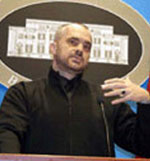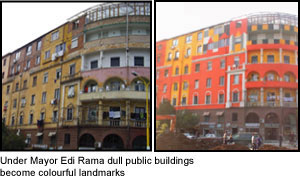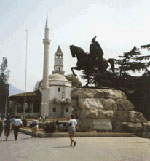
Edi Rama, Mayor of Tirana and 2004 World Mayor finalist for Europe
www.tirana.gov.al

FRONT PAGE
About us

The 2010 results
The 2010 project
The 2010 finalists
Code of Ethics
The World Mayor Prize

The 2008 results
The 2008 project
The 2008 finalists
The World Mayor Award

The 2006 results
Methodology
The 2006 finalists
The World Mayor Award

The 2005 results
Contest methodology
List of finalists
The World Mayor Award

Mayor of Athens
Mayor of Guatemala City
Mayor of Mississauga
Mayor of San Fernando
Mayor of San Francisco

Mayor of Athens
Mayor of Guatemala City
Mayor of Mississauga
Mayor of San Fernando
Mayor of Vienna

Comments on finalists from The Americas
Comments on finalists from Europe
Comments on finalists from Asia, Australia and Africa
Comments on Addis Ababa
Comments on Antananariva
Comments on Athens
Comments on Atlanta
Comments on Belo Horizonte
Comments on Bonn
Comments on Guatemala City
Comments on Karachi
Comments on London
Comments on Melbourne
Comments on Mississauga
Comments on Rio de Janeiro
Comments on Rome
Comments on San Fernando
Comments on San Francisco
Comments on Toronto
Comments on Vancouver
Comments on Vienna

Mayor of Addis Ababa
Mayor of Antananarivo
Mayor of Athens
Mayor of Belo Horizonte
Mayor of Bonn
Mayor of Ekaterinburg
Mayor of Guatemala City
Mayor of Innsbruck
Mayor of Karachi
Mayor of Kiev
Mayor of Melbourne
Mayor of Mississauga
Mayor of Munich
Mayor of Rhodes
Mayor of Rome
Mayor of Tshwane
Mayor of Vienna

The 2004 contest
List of all 2004 finalists
Edi Rama wins 2004 award
People ask - Edi Rama replies
Why we voted for the Mayor of Tirana
Why we voted for the Mayor of Mexico City
History of Tirana

Front Page
Site Search
About City Mayors
and Mayor of Tirana
By Nick Swift
Edi Rama’s journey to the mayor’s office in Tirana, the capital of Albania, arguably began in what most would call a raw and rough-and-tumble way inasmuch as, even though he, while still teaching at the Albanian Academy of Arts – admittedly a site of political ferment after the termination of communism and the birth of the Democratic Party in 1990 – had quickly left what he considered a bogus movement, and was doing no more than criticize both the socialists and the democrats in print, someone showed how seriously they took that by lying in wait for him in front of his home and beating him nearly to death. Mr. Rama is in no doubt that his attackers that night in 1997 were sent by then-president Sali Berisha.
 When he had finally regained his health, Edi Rama resumed his career as a painter and sculptor in Paris, but returned to Albania in 1998 when his father died, and after a new government under Fatos Nano had assumed power. The country then was the product of half a century of Stalinist dictatorship topped off with ten years of free market indiscipline, and layered with organized crime. The capital itself was mired in the waste of under-served overpopulation, with corruption in the civil service having facilitated the emergence of a chaos of illegal buildings and decaying streets.
When he had finally regained his health, Edi Rama resumed his career as a painter and sculptor in Paris, but returned to Albania in 1998 when his father died, and after a new government under Fatos Nano had assumed power. The country then was the product of half a century of Stalinist dictatorship topped off with ten years of free market indiscipline, and layered with organized crime. The capital itself was mired in the waste of under-served overpopulation, with corruption in the civil service having facilitated the emergence of a chaos of illegal buildings and decaying streets.
On the evening of the day in the morning of which Mr. Rama attended the service for his father, the phone rang, and it was Prime Minister Nano, who addressed him as ‘Mr. Minister of Culture’. Mr. Rama heard the call of duty, and answered, he says, without thinking. He soon found the straight-laced aspect of his role disagreeable, and it turned out that becoming (after getting permission) tieless was only the beginning; the restoration of blood flow to the future mayor’s head gave him the idea of opening movie theatres in Tirana, and showing popular foreign films in them, an entirely new phenomenon for Albania.
In October 2000, Mr. Rama ran as an Independent with Socialist Party support for the job of Mayor of Tirana, and won with a 54 per cent majority.
Within a month there was another attempt on his life when shots were fired into his flat.
Any idea of the artist as as impractical dreamer is shattered by Edi Rama’s achievements so far. He claims still to be an artist first and most of all, and activities in public service are an extension of his aesthetic sensibility into the realm of action and life. He shrewdly appraises the legacy of communism as a cultural and social toxin that cannot be eliminated except over time, and perhaps a very long time. But he is helping restore Tirana society’s immune system and positive attitude by, for example, the Return to Identity Programme, ruthlessly razing the haphazard and, often, environmentally seriously damaging outlaw buildings of all kinds in order to produce a clean slate on which urban planning can occur that will meet the needs of present and future generations.
He allied himself with the United Nations Development Programme in 2001, and launched the Clean and Green project in Tirana to deal with the consequences of the pollution of the Lana River, generating new green spaces and thousands of new trees. He has reduced unemployment, partly by putting Tiranans to work on such projects. Two years after becoming mayor, Edi Rama went to New York to collect the Poverty Eradication Award from United Nations Secretary General Kofi Annan. "I see this," he told Voice of America TV in Albanian, "as an important event for the capital rather than my personal life... This award represents recognition for a coordinated effort among many individuals and a synergy of energies and financial resources."
The depth and breadth of Mayor Rama’s vision and accomplishments to date belie the criticism that he is over-preoccupied with merely cosmetic changes, and that he illegitimately extends the legitimacy of his fondness for colourful shirts to a penchant for painting dull public buildings in the ‘Edi Rama colours’ of green, violet and yellow. The concise version of his reply to that charge is that it is, in essence, all to make the best possible impression on the sort of people Tirana and Albania have the most to gain by impressing favourably: foreign VIPs.
It is not as if he is unaware that the gaiety of those appearances is counterbalanced by the severe poverty that is the more apparent the farther one travels from the city centre.
Focusing the correctness of his politics on forms of integrity that matter to his constituents means that the tendency of his staff to be female and pulchritudinous should be, as far as he is concerned, of no signficance in view of the fact that they do their jobs well.
The Democratic Party of Albania in 2003 attempted to have a parliamentary commission established to investigate use of public funds by the municipality of Tirana, evidently with the intention of undermining Mr. Rama’s chances of being re-elected later in the year. They lost inasmuch as the commission, as a condition stipulated by the Socialist Party, will investigate as far back as 1992, when the Democrats themselves were in power: and, in 2004, Edi Rama is still Mayor of Tirana, with, this time, just under 59 per cent of the vote.

The centre of Tirana is Scanderbeg Square
Introducing
World Mayor 2006
The World Mayor project is now in its third year. As in 2004 and 2005, this year’s World Mayor will again be seeking out mayors who have the vision, passion and skills to make their cities amazing places to live in, work in and visit. The World Mayor project aims to show what outstanding mayors can achieve and raise their profiles. It honours those who have served their communities well and who have made contributions to the well-being of cities nationally and internationally. The most outstanding mayor of 2006 will be presented with the World Mayor award.
In 2004, Edi Rama, Mayor of Tirana, won the Award. The 2005 winner was Dora Bakoyannis, Mayor of Athens and now Greek Foreign Minister.
Between January and May each year, citizens from across the world are invited to nominate mayors for the World Mayor Award. They are also asked to provide reasons for their choice. After the close of the nomination stage, City Mayors, the organisers of the contest, prepare a shortlist of mayors who go forward to the second round of the World Mayor contest. In 2006, the list of finalists includes 50 mayors from North and South America, Europe, Asia, Australasia as well as Africa.
